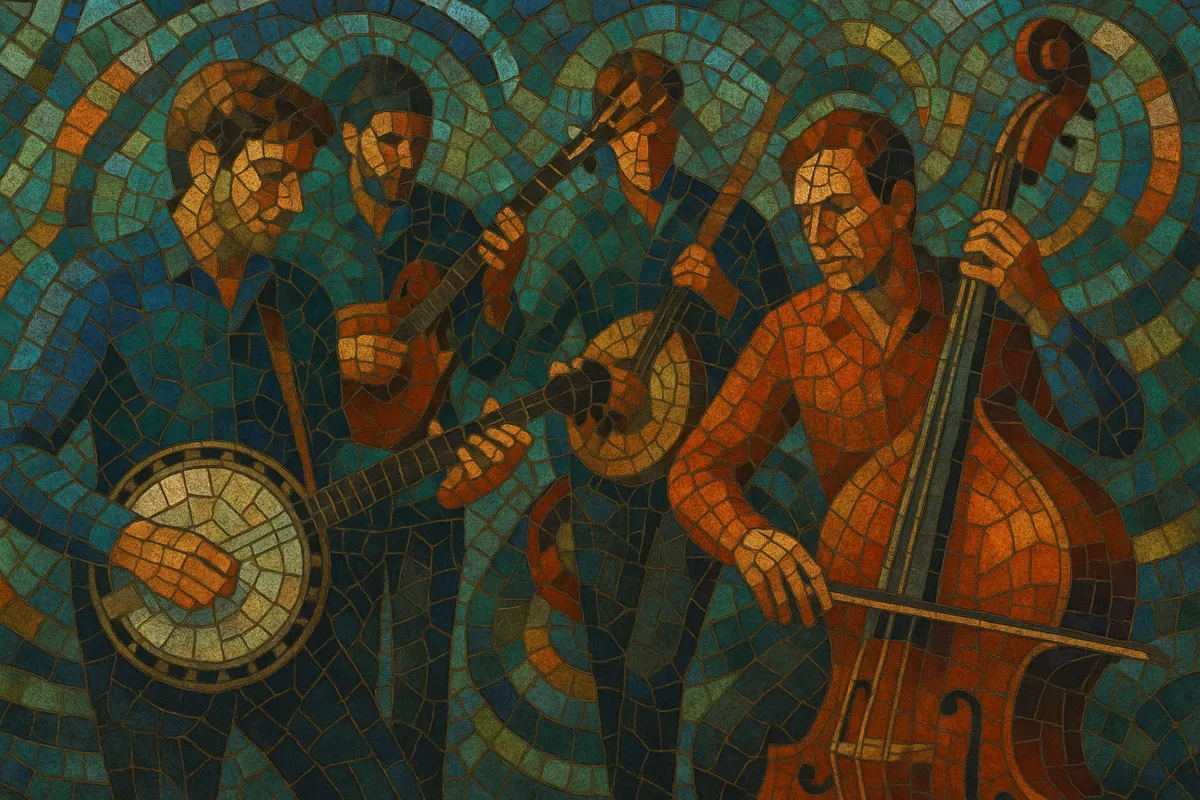
Progressive bluegrass is an expansionist, boundary‑pushing strain of bluegrass that blends the genre’s core acoustic instrumentation with the harmonic language, song forms, and improvisational practices of jazz, rock, folk, and contemporary songwriting.
Often called “newgrass,” it favors virtuosic soloing, sophisticated reharmonization, odd and mixed meters, and inventive arrangements. While it usually remains largely acoustic (banjo, mandolin, fiddle, guitar, dobro, upright bass), progressive bluegrass is comfortable with tasteful amplification, occasional drums or electric bass, and covers of non‑bluegrass repertoire.
The result is music that retains the drive and string-band precision of traditional bluegrass while embracing modern harmony, melodic invention, and improvisation inspired by jazz and progressive rock.
Progressive bluegrass emerged in the United States as younger bluegrass musicians began stretching tradition. Groups such as The Dillards and The Country Gentlemen expanded repertoire beyond the Appalachian canon, incorporating contemporary folk and pop material and experimenting with amplification. Flatpicking innovators like Clarence White (The Kentucky Colonels) influenced a generation of guitarists, while Washington, D.C.’s Seldom Scene established a template for urbane, harmony‑rich, and repertoire‑adventurous bluegrass.
The early–mid 1970s crystallized the movement. New Grass Revival (with Sam Bush and later Béla Fleck) explicitly branded the sound “newgrass,” infusing bluegrass technique with rock backbeat energy, extended solos, and complex arrangements. Simultaneously, mandolinist/composer David Grisman coined “Dawg music,” blending bluegrass drive with jazz harmony and chamber‑like interplay; guitarist Tony Rice brought modern jazz chords and fluid improvisation to flatpicking.
The 1980s saw further technical and stylistic advancement: Béla Fleck’s banjo vocabulary bridged bluegrass, jazz, and fusion; supergroups like Strength in Numbers showcased ensemble virtuosity; labels such as Rounder and Sugar Hill championed boundary‑pushing acoustic music. In the 1990s, Alison Krauss & Union Station broadened the audience with polished, contemporary production, while Nickel Creek introduced a youthful, pop‑aware sensibility to millennial listeners.
In the 2000s–2010s, Punch Brothers elevated compositional ambition with through‑composed pieces, odd meters, and classical‑leaning textures. Parallel to this, jamgrass acts like Yonder Mountain String Band and Greensky Bluegrass emphasized improvisational stretches and a festival‑friendly ethos (Telluride and other festivals serving as hubs). Today, progressive bluegrass remains a living laboratory for acoustic innovation, balancing tradition with continual stylistic cross‑pollination.
Start with a bluegrass string band: mandolin (chop rhythm and melodic leads), 5‑string banjo (Scruggs and melodic styles), fiddle (tunes and counterlines), acoustic guitar (flatpicking leads and cross‑picked rhythm), dobro (slides and harmonized fills), and upright bass (walking, two‑feel, and syncopated patterns). Progressive bluegrass can include tasteful drums or percussion, electric bass, or keys when the arrangement calls for expanded color.
Keep the bluegrass drive but vary feels: alternate between traditional two‑feel, backbeat‑leaning grooves, and mixed/odd meters (5/4, 7/8) for prog‑leaning passages. Use metric modulations or half‑time sections to create contrast. Encourage call‑and‑response trading of 8s/4s between instruments to highlight improvisation.
Move beyond I–IV–V by adding extended chords (maj7, 9, 13), secondary dominants, modal interchange (bVII, IV minor), and jazz‑influenced voice‑leading. Reharmonize traditional fiddle tunes with passing chords and pedal‑point harmony. Write memorable, singable melodies, then vary them via ornamentation (slides, triplets, double‑stops) and counter‑melodies in the fiddle/mandolin.
Combine song forms (verse/chorus/bridge) with tune structures (AABB). Introduce through‑composed intros, interludes, and codas. Orchestrate dynamically: begin with a lean duo, add instruments in layers, and feature solo spotlights. Arrange vocal harmonies with tight thirds/sixths and occasional jazz extensions for richness.
Encourage jazz‑style improvisation over chord changes; outline guide tones and use arpeggio substitutions. Guitarists can mix scalar runs with crosspicking; banjoists blend Scruggs rolls and melodic passages; mandolinists alternate chop chords with linear lines; fiddlers employ double‑stops and modal flights. Keep ensemble listening paramount to avoid clutter in dense textures.
Balance originals with inventive covers (folk, rock, pop) reimagined for strings. Lyric themes can range from traditional narratives to modern, introspective topics; ensure the storytelling sits naturally with the melodic contour and harmony.
Capture acoustic detail with close miking plus room ambience; consider minimal, transparent compression to preserve transients. Panning can mirror stage layout to maintain clarity during fast, interlocking lines.

